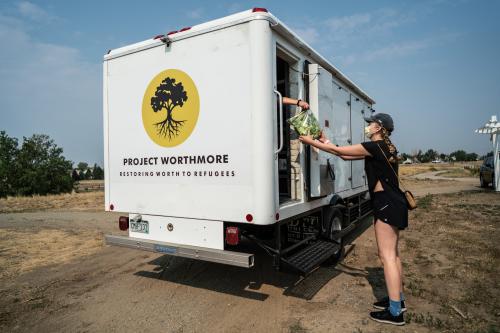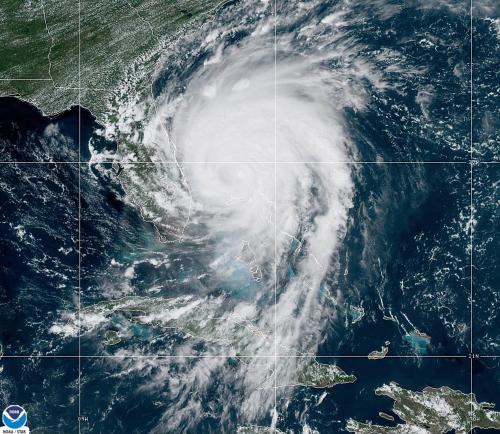Approximately 3.3 billion of the world’s inhabitants presently live in urban areas—a figure expected to increase to more than five billion people in the next twenty years. Perhaps a third of today’s urban residents live in informal settlements and slums which increases their vulnerability to crises. While humanitarian actors have delivered assistance in urban settings in the past (e.g. Sarajevo), the pace of urbanization and the increasing complexity of urban life mean that it is likely that future humanitarian operations will increasingly be carried out in cities. The Inter-Agency Standing Committee, UNHCR, and other international agencies have sought to develop new strategies and policies to respond to this new reality. In these brief remarks, I’d like to offer ten observations on the urban context and the way this may affect humanitarian approaches to protection in urban settings. While I’ll illustrate some of my comments with reference to Haiti, I suspect they will be applicable to other settings.
- Urban areas exhibit visible and often extreme disparities in income and wealth. Wealth is concentrated in cities and, in particular, in capital cities. Big banks, major retail and service operations, entertainment and public services all tend to be concentrated in cities. Because they provide more services and economic opportunities, urban areas have long been magnets for rural-urban migration—particularly for migration of the young and mobile. But cities are also places of poverty, marginalization and inequality. Before the earthquake in Haiti, 49% of the population of Port-au-Prince was unemployed. [1] While in many countries, absolute poverty levels are higher in rural areas, rural poverty is often invisible to the nation’s urban elite. In cities, the poor are rarely invisible. Rich and poor live side-by-side in some places, but they also live in polarized communities.
- Urban areas are physically congested places. Land is at a premium and wealthy people tend to live in the most geographically safe and pleasant parts of the city while poorer communities live on land that is less safe. One year ago, a fire in Dhaka, Bangladesh killed 150 people, in part because the city streets were so narrow and congested that emergency equipment could not enter the affected neighborhoods. [2]
- Urban areas are violent places. Two of three inhabitants of cities are victims of crime in a five year period. [3] Most of the victims are poor and most of the crimes are committed by poor young men. Even before the earthquake, 35% of Haitian women living in urban areas reported being victims of physical violence—in comparison with ‘only’ 15% of Haitian women in rural areas.[4] Gangs, warlords, and dubious business interests are all active in cities—and these groups sometimes have more resources than government police forces. For example, last May, the Jamaican government’s attempt to arrest a drug dealer turned into a month-long assault on a public housing complex involving more than 1,000 police and soldiers. The effects were far-reaching; not only were 76 people killed, but the tourism industry suffered and a national emergency was declared.[5] The fact that there may be parts of cities where even armed police find it difficult to work has implications for humanitarian workers trying to assist people in emergency situations.
- The actors in urban settings are diverse. There are various levels of governmental authorities with different responsibilities and mandates that must be engaged to carry out humanitarian work. Ensuring water supplies to affected communities in an urban neighborhood requires usually much more consultation with different authorities than in a rural camp setting. Humanitarian actors need to engage much more with municipal authorities and there are encouraging signs in this direction. There is a huge range of capacity between municipal authorities in different cities within the same country; it seems to be a general trend that national governments set policies to be carried out at the local level but rarely provide the necessary resources to do so. And of course there are usually a more diverse and more active range of non-state actors in urban settings, including business interests, gangs and highly developed and active civil society organizations.
- Urban populations tend to be more mobile. People not only move within cities, they also move between cities. While there is a lot of research on rural-urban migration, there is less on patterns of intra-urban displacement. The case of Haiti after the earthquake is a case in point whereby some urban residents moved to rural areas after the earthquake but then moved back to Port-au-Prince, perhaps because services didn’t materialize. And residents of Port-au-Prince moved within the city, between damaged houses and tent settlements, making it difficult for humanitarian agencies to reliably estimate the numbers of the displaced and to develop appropriate programs.
- Urban populations are more politically active and have more access to information than those in rural areas. Historically governments have always worried more about urban populations—their potential for protests, strikes and political activities. They have reason to fear. It’s hard to imagine protest movements centered in rural Egypt or Tunisia, for example, having the same impact as the uprisings in Cairo and Tunis. That is probably one of the reasons governments feel more pressure to provide services in urban areas than in rural ones. And urban populations generally have more access to information than those living in rural areas. For example, I was told by an NGO worker in Haiti of a case where a representative of a camp committee challenged her: “I saw on your website that you’ve raised a million dollars for Haiti—where is the money going?”
- Determining beneficiaries for humanitarian programs is particularly difficult in cities. In Haiti, humanitarian agencies tried to do what they do best: provide assistance to displaced populations. But distinguishing the displaced from the urban poor is difficult. In fact, programs to assist the displaced in Haiti may have ended up creating new IDPs as people left their homes for the settlements in the hope of receiving assistance or ‘commuted’ back and forth between settlements and other accommodations. In this regard, perhaps it’s time to re-examine the concept of ‘host’ communities, particularly the interaction between displaced persons and the communities in which they live. I suspect that in the cities the dividing line isn’t so clear, given that the ‘host’ communities may themselves be displaced.
- It seems more difficult to discern the boundaries between humanitarian and development assistance in urban areas. The line between the two types of work is often blurred, but it seems to take on a different dimension in urban settings. Providing water or health care to IDPs in an urban area, for example, may mean supporting the city’s service architecture rather than delivering water or medical care to targeted IDPs. Protecting IDPs in Haiti or in the Democratic Republic of the Congo, for example, means working on issues of security sector reform. No humanitarian agency is well-equipped (or has the mandate) to deal with the needs of the “urban poor.”
- Finding solutions for those displaced or otherwise affected by emergencies may not be more difficult in urban than rural settings, but it involves a unique set of challenges. Land issues are notorious impediments to solutions for displaced populations in all areas, but are particularly complicated in cities. For example, meeting the needs of those who rented accommodations or squatted on land owned by others is almost always an issue in urban settings.
- Humanitarian actors have tended to see conflict situations and natural disasters as two distinct phenomena. Several of the clusters, for example, have named different cluster leads for natural disasters and conflicts or complex emergencies. But the two seem to be converging in cities. Natural disasters are more likely to affect poor urban residents living on marginal land than their wealthier compatriots. These marginal areas are also often the territories of criminals, urban gangs, traffickers and traditional insurgent groups. The ‘no-go’ areas of cities may be precisely those most vulnerable to natural hazards, creating difficulties for humanitarian actors in accessing disaster-affected communities.
These characteristics challenge the way we think about protection and protection tools we have developed. For example, what does ‘creating humanitarian space’ mean when those challenging humanitarian space are urban gangs and business interests? What does supporting participation and diversity mainstreaming mean when people are moving in and out of camps and where the committee leadership may be linked with other interests? How can humanitarian actors provide physical protection when local police forces are either non-responsive or lack capacity or both? How can protection needs assessments be carried out among very mobile communities? It is a very positive sign that humanitarian organizations are aware of the need to use an urban ‘lens’ to re-examine their tools and to develop strategies and practices specifically for work in urban areas. [8] Future humanitarian work is likely to be increasingly carried out in cities.
[1] World Bank, ‘Social Resilience and State Fragility in Haiti, A Country Social Analysis, Report No. 36069–HT’, 2006. <http://siteresources.worldbank.org/BOLIVIA/Resources/Haiti_CSA.pdf>.
[2] Daily Mail Online, “Dhaka fire death toll 100 and rising as rescue crews recover bodies and search for survivors,” 4 June 2010, www.dailymail.co.uk/news/article-1283919/Dhaka-death-toll-rises-rescue-crews-recover-bodies-search-survivors.html
[3] United Nations Human Settlements Programme UN–HABITAT, State of the World’s Cities 2004–05: Globalization and Urban Culture, 2004, p. 134.
[4] World Bank, op cit.
[5] Tom Hays, “Christopher ‘Dudus’ Coke, Alleged Jamaican Drug Lord, Pleads Not Guilty In New York,” Associated Press, 25 June 2010, www.huffingtonpost.com/2010/06/25/christopher-dudus-coke-pleads_n_626281.html
[6] See IASC above, for example


Commentary
Op-edTen Observations on the Challenges of Humanitarian Work in Urban Settings
June 30, 2011